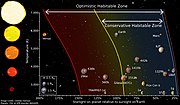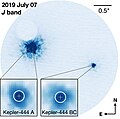star Kepler-22. It is located about 640 light-years (200 parsecs) from Earth in the constellation of Cygnus. It was discovered by NASA's Kepler Space...
19 KB (1,838 words) - 14:54, 15 November 2024
Kepler-22 is a Sun-like star in the northern constellation of Cygnus, the swan, that is orbited by at least 1 planet found to be unequivocally within...
10 KB (661 words) - 01:51, 27 December 2024
In astronomy, Kepler's laws of planetary motion, published by Johannes Kepler in 1609 (except the third law, and was fully published in 1619), describe...
60 KB (8,841 words) - 03:40, 3 January 2025
Kepler-452b (sometimes quoted to be an Earth 2.0 or Earth's Cousin based on its characteristics; also known by its Kepler object of interest designation...
21 KB (2,002 words) - 19:19, 14 December 2024
zone: Kepler-560b, Kepler-705b, Kepler-1229b, Kepler-1410b, Kepler-1455b, Kepler-1544 b, Kepler-1593b, Kepler-1606b, and Kepler-1638b. The Kepler team...
186 KB (16,796 words) - 19:33, 28 October 2024
Solar System. Retrieved 2021-01-29. "K2-288 B b - NASA Science". "Confirmed Planet Overview Page: Kepler-22 b". NASA Exoplanet Archive. NASA Exoplanet Science...
58 KB (3,095 words) - 13:04, 26 December 2024
Kepler-16b (formally Kepler-16 (AB)-b) is a Saturn-mass exoplanet consisting of half gas and half rock and ice. It orbits a binary star, Kepler-16, with...
19 KB (1,807 words) - 05:19, 23 August 2024
2017-09-04. Retrieved 2018-02-28. "Kepler 22-b: Earth-like planet confirmed". BBC News. 2011-12-05. Retrieved 2012-01-22. Pultarova, Tezera (11 August 2023)...
35 KB (2,706 words) - 04:05, 20 November 2024
List of multiplanetary systems (redirect from Kepler-55)
with the most confirmed planets are the Sun (the Solar System's star) and Kepler-90, with 8 confirmed planets each, followed by TRAPPIST-1 with 7 planets...
266 KB (9,020 words) - 20:23, 1 January 2025
This is a partial list of exoplanets discovered by the Kepler space telescope, running from star number 1 through 500, inclusive. All lists: 1–500 501–1000...
170 KB (2,918 words) - 06:55, 29 June 2024
planet outside the circumstellar habitable zone. Kepler-22 b, discovered in December 2011 by the Kepler space probe, is the first transiting exoplanet discovered...
134 KB (13,720 words) - 16:19, 6 November 2024
Earth's perspective, is 14.87. Therefore, Kepler-70 is too dim to be seen with the naked eye. Kepler-70 is an sdB (B-type subdwarf) star with a temperature...
12 KB (1,094 words) - 18:13, 23 August 2024
system via NASA's Kepler space telescope in 2012. In November 2013, evidence of a third planet orbiting between the planets b and c, Kepler-47d, was announced...
23 KB (2,151 words) - 08:11, 17 November 2024
the primary, Kepler-16A, is a K-type main-sequence star and the secondary, Kepler-16B, is an M-type red dwarf. They are separated by 0.22 AU, and complete...
9 KB (489 words) - 10:30, 9 May 2024
1086/432901. S2CID 16509245. Archived (PDF) from the original on 22 July 2018. "Kepler 22-b: Earth-like planet confirmed". BBC. 5 December 2011. Retrieved...
52 KB (5,887 words) - 01:07, 14 December 2024
Kepler-452 is a G-type main-sequence star located about 1,810 light-years away from Earth in the Cygnus constellation. Although similar in temperature...
13 KB (1,189 words) - 08:01, 9 May 2024
for Aliens on Kepler's Worlds". Discovery News. Archived from the original on 30 August 2012. Mack, Eric (7 December 2011). "Kepler 22-b a top target in...
110 KB (12,057 words) - 06:58, 31 December 2024
Kepler-62 is a K-type main sequence star cooler and smaller than the Sun, located roughly 980 light-years (300 parsecs) from Earth in the constellation...
17 KB (1,612 words) - 03:25, 3 November 2024
Kepler-186 is a main-sequence M1-type dwarf star, located 177.5 parsecs (579 light years) away in the constellation of Cygnus. The star is slightly cooler...
17 KB (1,540 words) - 03:22, 3 November 2024
Kepler-62f (also known by its Kepler Object of Interest designation KOI-701.04) is a super-Earth exoplanet orbiting within the habitable zone of the star...
24 KB (2,427 words) - 09:20, 19 November 2024
Kepler-1625b I is a possible moon of exoplanet Kepler-1625b, which may be the first exomoon ever discovered (pending confirmation), and was first indicated...
7 KB (602 words) - 20:19, 2 November 2024
Kepler 6B (Spanish: Kepler Sexto B) is a 2023 Spanish-French drama film directed by Alejandro Suárez Lozano (in his directorial feature length debut) which...
8 KB (528 words) - 17:54, 14 December 2024
Kepler-138, also known as KOI-314, is a red dwarf located in the constellation Lyra, 219 light years from Earth. It is located within the field of vision...
21 KB (2,009 words) - 03:27, 31 August 2024
Kepler-444 (or KOI-3158, KIC 6278762, 2MASS J19190052+4138043, BD+41°3306) is a triple star system, estimated to be 11.2 billion years old (more than 80%...
21 KB (1,400 words) - 00:31, 18 November 2024
Kepler-186e (also known by its Kepler Object of Interest designation KOI-571.04) is a confirmed exoplanet orbiting the red dwarf star Kepler-186, approximately...
11 KB (988 words) - 05:20, 23 August 2024
times that of Earth, Kepler-445c is likely a mini-Neptune with a volatile-rich composition, and has been compared to GJ 1214 b. Kepler-445d is only slightly...
6 KB (348 words) - 02:01, 27 September 2023
is host to exoplanets Kepler-37b, Kepler-37c, Kepler-37d and possibly Kepler-37e, all of which orbit very close to it. Kepler-37 has a mass about 80...
16 KB (1,411 words) - 05:26, 23 August 2024
Kepler-1652b (also known by its Kepler Objects of Interest designation KOI-2626.01) is a super-Earth exoplanet, orbiting within the habitable zone of the...
7 KB (772 words) - 11:10, 16 June 2024
more than twice as dense (about 12.6 g cm−3) as the innermost exoplanet Kepler-107 b (about 5.3 g cm−3). Vallenari, A.; et al. (Gaia collaboration) (2023)...
7 KB (462 words) - 15:28, 26 October 2024
Kepler-223 (KOI-730, KIC 10227020) is a G5V star with an extrasolar planetary system discovered by the Kepler mission. Studies indicate that the Kepler-223...
7 KB (538 words) - 01:43, 28 April 2024




















